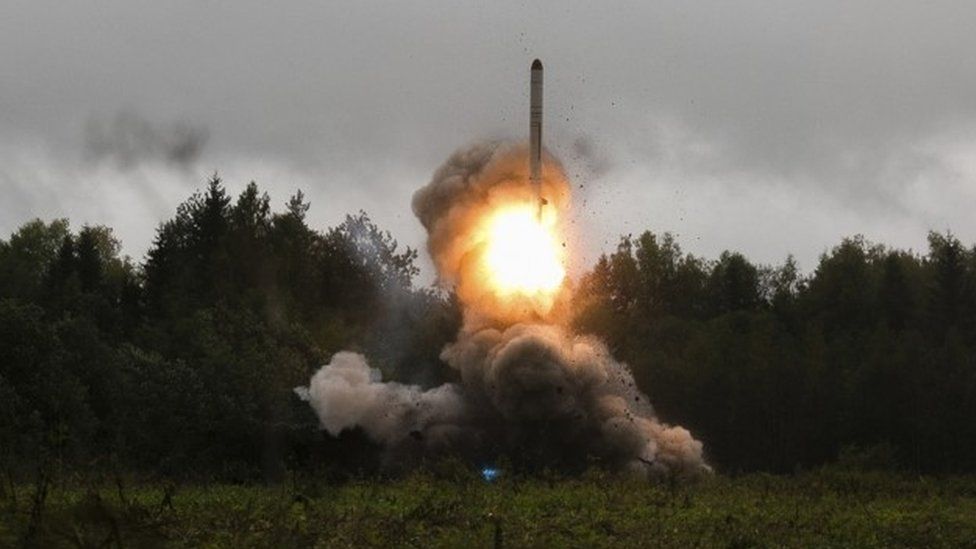Pentagon urges missile defence sensors in space
- Published

The US must research new technologies, such as a layer of sensors in space, to find and destroy incoming missiles, a Pentagon report says.
The Missile Defence Review says the US should revamp its missile defence programme to combat foreign threats.
It includes plans to study a possible orbital sensor system to intercept and stop missiles in their tracks.
"The world is changing and we're going to change much faster," President Trump said as he unveiled the review.
The president previously ordered the military to create a sixth branch of the military to ensure "American dominance in space".
Speaking ahead of the review's publication, an unnamed official reportedly said space was "the key" to missile defence.
"A space-based layer of sensors is something we are looking at to help get early warning and tracking and discrimination of missiles when they are launched," the official told reporters.
However, the official stressed the military was only examining whether such a system could work, and that no decisions had been made.
It comes after previously announced plans for more ground-based defence systems in Alaska.
The review comes months after an expert commission published a sober report on President Trump's defence strategy which argued the US "margin of superiority" is now "profoundly diminished".
It said there are "urgent challenges that must be addressed if the United States is to avoid lasting damage to its national security.
The weapons proposals in the new defence review echo US plans developed in 1980s.
Known as "Star Wars", the Strategic Defence Initiative was a planned missile shield to protect the US from intercontinental ballistic missiles.
President Ronald Reagan announced the concept in 1983, but it was eventually dropped in 1993 after the end of the Cold War.
A new arms race?
Analysis by Jonathan Marcus, BBC Defence and Diplomatic correspondent
While it may all sound like a reprise of the ambitious "Star Wars" plans, the Pentagon's new proposals are more limited.
Nonetheless, they would expand significantly on the missile defences that the US currently deploys.
The aim is not just to defend against attacks from rogue states like North Korea, but to provide more expansive regional defences to cover deployed US forces and allies in key strategic areas of the world.
But there are three fundamental questions to pose about Mr Trump's enthusiasm for expanded missile defence: Will the technologies - many of them not yet available - actually work? What will be the cost? And crucially what will be the strategic implications?
Russia (and China too) may see all this as something that will undermine its own nuclear forces, potentially leading to a new arms race.
While the US has recently focused its efforts on containing regional threats like North Korea and Russia, both China and Russia have been developing new weapons which some see as a threat to US military superiority.
Russia has reportedly tested a hypersonic missile, while in 2018 the head of the Defence Intelligence Agency told Congress China was trying to counter missile defences by developing "increasingly sophisticated ballistic missile warheads and hypersonic glide vehicles".
The US currently deploys four systems capable of destroying in-coming ballistic missiles, the BBC's Jonathan Marcus explains:
- Ground-Based Midcourse Defence
Designed to counter incoming strategic ballistic missiles in the mid-course stage of their flight, they were first deployed in 2004. Today there are some 44 interceptor missiles deployed - the bulk of them are at Fort Greely in Alaska, with a small number at Vandenberg Air Force base in California. These are backed up by a variety of sea and land-based radars. The interceptor's kill vehicle is designed to hit the incoming warhead, something likened by some to hitting "a bullet with a bullet"
- Aegis Ballistic Missile Defence
Deployed both at sea on Aegis-equipped US warships and at two equivalent bases on land in Romania and another under construction in Poland. This system uses the powerful sensors of the Aegis combat system on board the warships along with variants of the Standard missile. Another hit-to-kill system.
- Terminal High Altitude Area Defence (THAAD)
A more mobile system involving interceptor missiles and radars, which - as the name implies - is useful for defending a more limited area. Operated by the US Army, batteries are deployed in Guam, South Korea and Hawaii.
- PATRIOT PAC-3
Deployed by several countries around the world, this is a development of an anti-aircraft system designed to defend against short and medium-range ballistic missiles in the final stages of their flight. These defences are backed up by the Space-Based Infrared System-High (SBIRS-High) a small network of four dedicated satellites (two more are planned) and three additional sensors on other satellites. Their purpose is to provide early warning of missile launches.
- Published4 December 2018
- Published2 February 2018
- Published28 February 2017
- Published18 December 2017
- Published10 August 2018